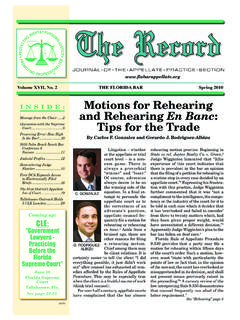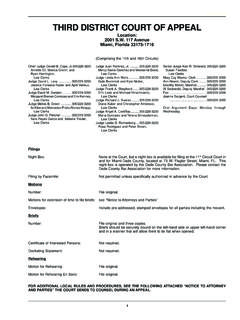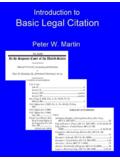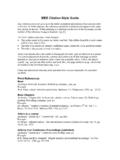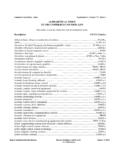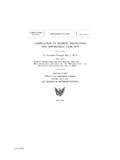Transcription of Citation Form: Getting it Right - The Florida Bar
1 84 THE Florida BAR JOURNAL/MARCH 2000 Citation form : Getting it RightThe rules havechanged sincemost of us went tolaw school. Ourmemory of the formslearned in lawschool may havefaded or becomecrowded Susan W. FoxEAppellat e Pr act ice and Advocacyvery lawyer needs to knowproper Citation form . Sloppyor inaccurate form suggestsinattention to detail or ig-norance of the correct form . Evenso, errors in Citation form are ram-pant is today s legal writing. Andnot just in lawyers writing judi-cial opinions contain errors, are several possible rea-sons for this. The rules havechanged since most of us went tolaw school. Our memory of theforms learned in law school mayhave faded or become crowded outby more recent information. Whilesome forms may have become sec-ond nature to us, others are merelyan educated guess unless we lookthem up every time we use articles and CLE lectureson the topic are rare, we do not re-main as current on this subject ason those that are covered fre-quently.
2 Some newer forms of cita-tion have developed through the useof the Internet, and rules for cita-tion of those sources are just devel-oping. Bottom line, we all focus onthe substance of our writing morethan on the article will explain theproper current forms of Citation inFlorida and will also clarify somecommon misunderstandings of thecitation of Citation RulesFlorida lawyers have two mainsources of Citation forms: TheBluebook: A Uniform System of Ci-tation (16th ed.), published in 1996by the Harvard Law Review Asso-ciation, and Rule , FloridaRules of Appellate Procedure, whichsets forth Florida s Uniform Sys-tem of Citation . Rule appliesin all appellate proceedings inFlorida; other citations not coveredin the rule should follow theBluebook. Citations not covered inthis rule or in The Bluebook shallbe in the form prescribed by theFlorida Style Manual published bythe Florida State University LawReview, Tallahassee, Fla.
3 32306. Fla. R. App. P. (k).Purpose of Citation RulesFlorida s Citation system wasadopted by the Supreme Court ofFlorida to standardize appellatepractice and ease the burden on thecourts. Fla. R. App. P. s notes. It is the duty ofeach litigant and counsel to assistthe judicial system by use of thesestandard forms of Citation . Id. Ap-parently, the court believes thatnonstandard forms are a burdenand fail to assist courts. The basic purpose of a legal ci-tation is to allow the reader to lo-cate a cited source accurately andefficiently. Bluebook at 4. Citationforms are designed to provide theminimum amount of informationnecessary to lead the reader to thesource and to convey key informa-tion concerning the source. See Citation consists of three basicparts: an introductory signal; a de-scription of the authority; and an op-tional parenthetical phrase explain-ing its relevance.
4 The rules for eachof these sections are discussed Signals every type of legal writing, thecitation of an authority is custom-ary to show support for or contra-diction of legal or factual proposi-tions or arguments. Theintroductory signal tells the readerhow the authority relates to yourproposition. This is true in appel-late briefs, judicial opinions, andeven in opinion letters, as well asin scholarly may think that it is unnec-essary to use introductory signalsfor simple legal writing. Unfortu-nately, this is not the case. It is al-most never correct to cite an author-ity without an introductory are ten introductory sig-nals: [no signal]; accord; see; seealso; cf.; compare .. with ..; butsee; but cf.; see generally; and (when used in combination withTHE Florida BAR JOURNAL/MARCH 2000 85other signals). The first five indicateauthorities that support a statedproposition.
5 The sixth suggests auseful comparison. The seventh andeighth show contradiction. Theninth indicates helpful backgroundmaterial. The last, , indicatesthe cited authorities are proper use of signals is ad-dressed in further detail below. [No signal], which is the citationof an authority without an introduc-tory signal, is now used only to iden-tify the source of a quotation in thepreceding sentence or to furtheridentify an authority referred to inthe text. Thus, except for these twoinstances, an authority may not becited without an introductory is a drastic change from whenmost of us went to law school; inthose days [no signal] was commonand signified that an authorityclearly stated the proposition in thetext. The [no signal] signal is nolonger used to indicate that the casesupports the proposition you havejust stated. Additionally, the [nosignal] signal cannot be appropri-ately used in advance of a string ci-tation, since the quotation or au-thority referred to in the text wouldbe only a single source.
6 See is used to indicate that theauthority directly states or clearlysupports the proposition addressedin the text. Bluebook at 22. Whileprior editions of the Bluebook al-lowed use of see to show an author-ity that clearly states a proposition,in common practice, this role wasgiven to [no signal]. See, ,Bluebook at 22 (15th ed. 1991). The clearly states function formerlyascribed to [no signal] was trans-ferred entirely to the see signal inthe 16th edition Bluebook. For-merly, see was used instead of [nosignal] primarily when the propo-sition was not directly stated in theauthority but logically followed fromanother principle stated in it. Thisfunction is not covered in the cur-rent Bluebook. See also is used when the citedauthority constitutes additionalsource material that supports theproposition. Bluebook at 22. Use itafter you have already quoted anauthority using [no signal] or havesupported a proposition using see.
7 A parenthetical explanation follow-ing such a cite is strongly encour-aged. Accord is used when a singleauthority is quoted in the text, butone or more other cited authoritiesalso clearly support the proposi-tion. Id. The signal is also used toshow that the law of another juris-diction is in accord with the citedauthority. Cf. identifies support of a propo-sition different from the main propo-sition, but sufficiently analogous tolend support. Parenthetical expla-nations are strongly recom-mended. Bluebook at 23. Compare .. [and] .. with ..[and] .. suggests a useful compari-son or illustrates the the relevance of the compari-son will usually be apparent only ifexplained, parenthetical explana-tions are strongly recommended. Id. But see introduces an authoritythat clearly supports a propositioncontrary to the main where see would be used forsupport.
8 But cf. signifies an authoritythat supports a proposition analo-gous to the contrary of the mainproposition. Again, a parentheticalexplanation is strongly recom-mended. Bluebook at 23. See generally suggests that thecited authority presents helpfulbackground information related tothe proposition. A parenthetical ex-planation following each such au-thority is again encouraged. changed its function in the16th edition Bluebook; it was elimi-nated altogether as a stand-alonesignal, and can now be used only incombination with other the old system, the sig-nal meant that the writer could citemany authorities for the proposi-tion, but was naming just a , it would be used, for example,with see to signify citations ofsample case(s) directly supportinga well-established one of the more quizzical tech-nicalities, one of the signals that cannow be combined with is the [no signal] signal.
9 This, of course,would result in the use of allby itself, which seems to restore as a stand-alone signal. Suchwould be appropriate, however, onlyif the text quoted a statement forwhich the writer chose to cite to onlyone or a few sources by way of ex-ample. Contra has been eliminated en-tirely as a signal, its function hav-ing been transferred to the but see signal. While contra had been usedto show authority directly contraryto the cited proposition, just as [nosignal] would be used for directsupport, it has now been removedfrom the lexicon. Thus, the mostcommon past usages of both contra (direct contradiction) and [no sig-nal] (direct support) have beenmerged into but see and see a frustrating omission, the edi-tors of the Bluebook no longer tellus how to signal that the proposi-tion obviously follows from the citedauthority (with an inferential step),although not directly stated in it.
10 Inprior editions, see was commonlyused as this signal, but see is nowlimited to direct or clear support,and the Bluebook is silent on indi-rect support. Writers will be left tomake the judgment call as towhether the authority s support isdirect enough to warrant use of see, or is so indirect as to requirethe ambiguous Cf. Since the onlyother signals that show support see also and accord are clearlylimited (consistent with prior edi-tions) to citations of additional au-thority where a primary case hasalready been cited, the eliminationof a method of citing indirect sup-port creates a troubling lack of of Source Rules for Citing CasesThe anatomy of a Citation to a caseis known to all lawyers and need notbe explained. The basic rules will betouched on in passing only, andsome rules that may not be as wellknown will be covered Citation forms are as fol-86 THE Florida BAR JOURNAL/MARCH 2000lows: Fenelon v.

